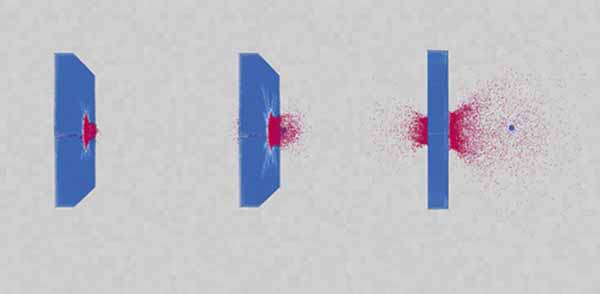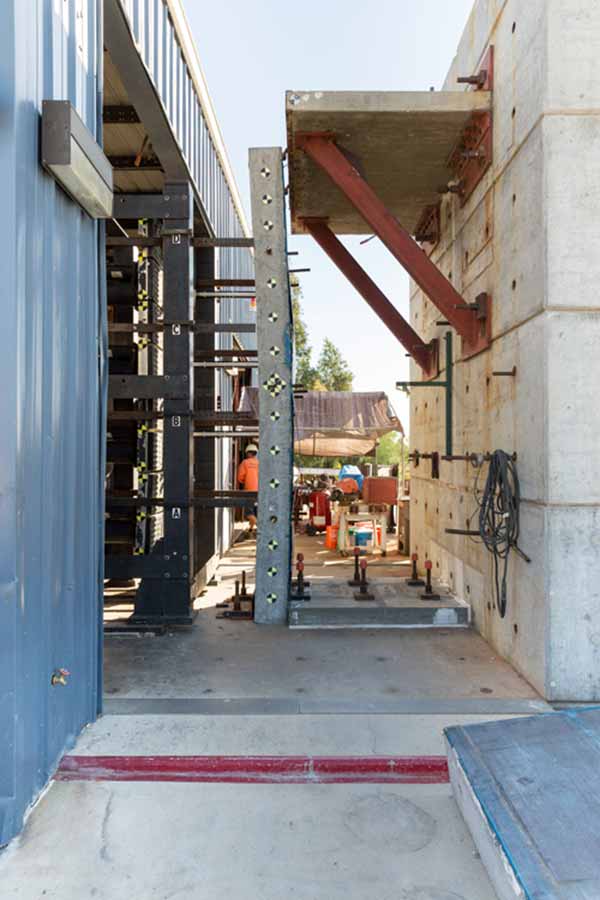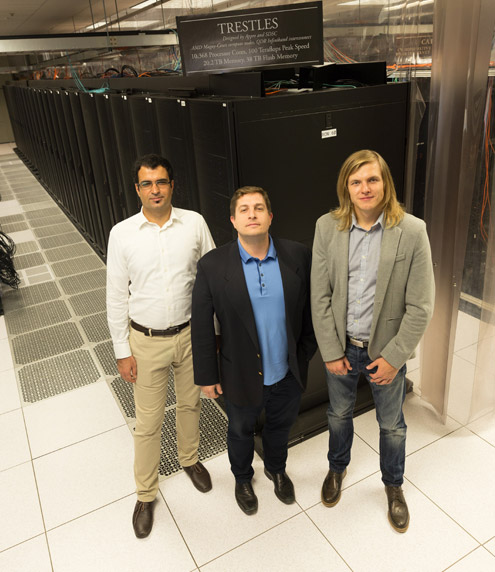
UC San Diego Jacobs School of Engineering Launches Center for Extreme Events Research
By:
- Ioana Patringenaru
Published Date
By:
- Ioana Patringenaru
Share This:
Article Content
Engineers at the University of California, San Diego, have launched a new center of excellence focused on developing better ways to protect buildings, bridges, dams and the rest of the built infrastructure, as well as the human body, from extreme events such as blasts from terrorist attacks, mining explosions, car crashes, sports collisions and natural disasters such as landslides and earthquakes.

Simulation of a bullet impacting a concrete wall. Photo: Courtesy of J.S. Chen/Jacobs School of Engineering/UC San Diego
The Center for Extreme Events Research (CEER) at the UC San Diego Jacobs School of Engineering brings together a unique combination of experts in experimental and computational research to tackle these problems. As a result, faculty will be able to develop sophisticated simulation tools and validate them experimentally.
“We need to be prepared for the next generation of threats,” said J.S. Chen, the center’s director and the William Prager Endowed Chair Professor of Structural Engineering at the Jacobs School of Engineering at UC San Diego. “My role is to bring together the fantastic expertise we already have here at UC San Diego, especially in the field of assessment and mitigation of extreme events.”
Unique Experimental Facilities
The center is home to the Extreme Events Simulator, the only facility of its kind in the world. The simulator is capable of replicating everything from blasts generated by car bombs to damage due to hurricane-force winds. The simulator uses the high-speed motion from several actuators—motors driven by a piston-like motion— to replicate the shockwave created by a blast or other type of impact, without a fireball. The damage caused by the shockwave can be captured with high-speed cameras and other sensors. Gil Hegemier, a Distinguished Professor of Structural Engineering at the Jacobs School, is the center’s associate director and leads its experimental efforts.
“We want to provide outcome-oriented results to benefit society,” Hegemier said.
Hegemier, an expert in blast and earthquake damage assessment, was called to the site of many natural and man-made disasters, including the World Trade Center after Sept. 11 and the San Francisco Bay Bridge after the 1989 Loma Prieta Earthquake. He designed the blast simulator in collaboration with former Jacobs School Dean Frieder Seible and MTS Corporation.

The Extreme Events Simulator is capable of replicating everything from blasts generated by car bombs to damage due to hurricane-force winds
The center also is home to other testing technologies, including a gas gun designed to test the impact of blasts and projectiles, both man-made, such as bullets, and caused by natural phenomena, such as hail. Structural engineering professor Hyonny Kim is leading this effort.
Unparalleled Extreme-Event Simulation Expertise
In addition, the center brings together experts in high-end simulation methods, such as finite element analysis, isogeometric analysis and mesh-free modeling. Chen is an expert in the latter. Mesh-free modeling uses points such as pixels in an image as data points for computer simulation. The method is especially adept at simulating blasts because it can track fragments from damaged materials and the impacts they cause. Chen’s group has also expanded the use of mesh-free simulation methods to biomechanics, for example, with an investigation of how aging and disorders impact muscle functions, such as muscular dystrophy.

Yuri Bazilevs, center, is associate director of the center and an expert in finite element analysis and isogeometric analysis. He is pictured here with postdoctoral researcher Kazem Kamran, left, and Ph.D. student Artem Korobenko, right.
Yuri Bazilevs, an expert in finite element analysis and isogeometric analysis and an associate director of the center, leads efforts in the field of computational simulation. He works on problems ranging from the simulation of offshore wind turbines in rough sea conditions to modeling of cardiac assist devices that save patients’ lives. His most recent research interest lies in the modeling of blast-structure interaction events, which is a highly complicated problem. It involves dynamic interaction between structures that fracture and disintegrate and the surrounding air flow containing shock waves and turbulence. Such phenomena are difficult to accurately model on a computer and can only be addressed by the interdisciplinary expertise of the center’s members.
Education, Workshops and Software
The Center for Extreme Events has a crucial educational mission, in addition to the cutting-edge research. “We need to prepare the next generation of engineers to deal with these disasters,” Hegemier said. Ph.D. students working with the center’s faculty will be exposed to a variety of disciplines and so will be extremely competitive in the jobs marketplace.
“The unique expertise of the center faculty enables us to offer an array of graduate-level courses in experimental and computational methods that are unparalleled in any other institution,” Bazilevs said. “This, in turn, attracts top graduate students to our graduate programs and greatly enhances the quality of research work coming out of the Center for Extreme Events Research.”
The Center will also offer multi-disciplinary workshops and short courses; one-on-one collaborations with faculty, researchers and graduate students; first-look at highly qualified Ph.D. students; and directed research projects, among other things. More information on ways to interact with the Center is available on the Center for Extreme Events website.
Chen also envisions the creation of software packages for modeling extreme events that would make available to center members and partners from government agencies and industries.
Share This:
You May Also Like
Stay in the Know
Keep up with all the latest from UC San Diego. Subscribe to the newsletter today.


